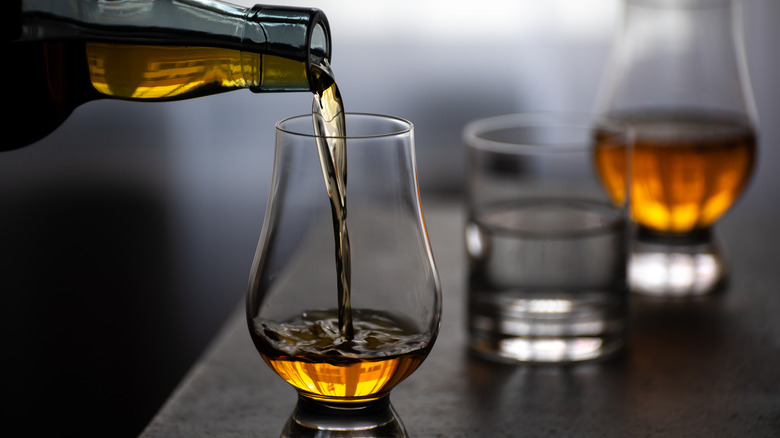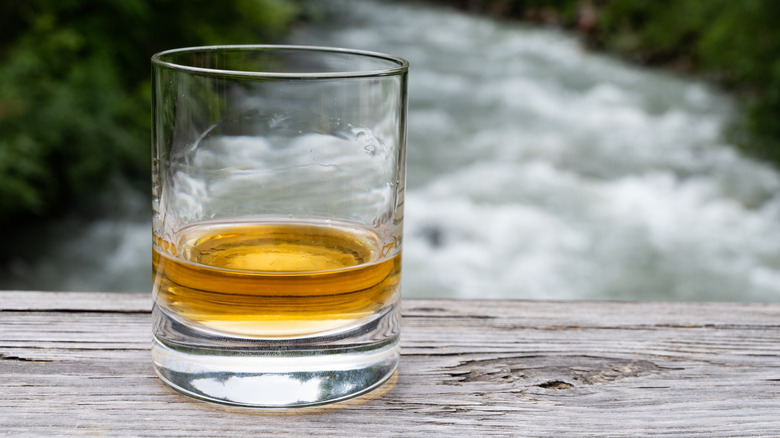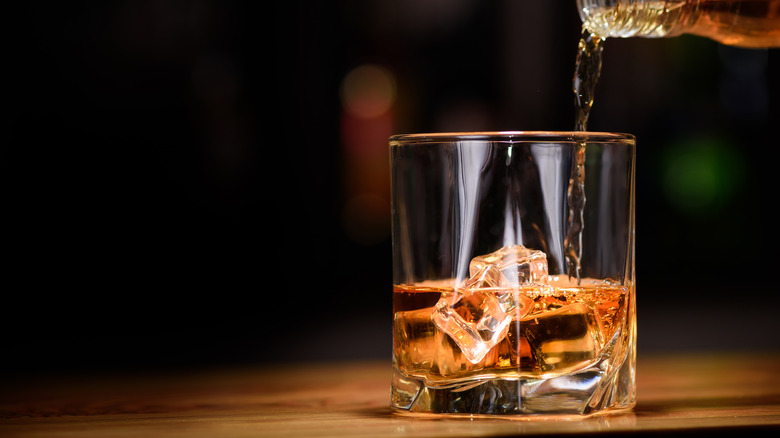How Much Water You Should Add To Whiskey For The Best Tastings
While you may prefer to take whiskey neat, if you've ever been to a professional tasting, you're probably familiar with the concept that adding a drop of water to the whiskey helps to open it up, so you can appreciate the full aroma and flavor profile. But what does that actually mean? And how much water should you add for the best result, and to avoid heavily diluting what is an expensive tipple?
To help find the answers, scientists at Washington State University diluted 25 different types of whiskies, including bourbons, ryes, Irish whiskey, and Scotch, with increasing amounts of water, and analyzed the chemical changes that took place. According to the results of the 2023 study published by the journal Foods, it turns out that there is actually a perfect volume of water to add to your whiskey, and it's based on science rather than personal preference. That amount is 20%.
In the study, a sensory panel of experts assessed a selection of the different whiskies and found that when they were undiluted, they could easily differentiate between each type. Adding a little water enhanced the aroma, and when the amount of water was 20% of the drink, they were still distinguishable. But when the whiskies were diluted with over 20% of water, they started to smell similar to the team. Since smell and taste are tightly linked, this "likely affected the spirit's flavor as well," the scientists concluded (via WSU Insider.)
The science behind adding water to whiskey
For the 2023 Washington State University-led study, scientists looked in detail at the headspace (the area between the surface of the liquid and the top of the glass) and evaluated how the volatile compounds in the whiskies responded when water was added in varying proportions. What water does to whiskey is a complicated business involving atomic density, but previous research shows that it partly comes down to a single molecule — one called guaiacol.
Providing some of the signature smoky flavors we associate with whiskey, and with a good Scotch especially, guaiacol enters the whiskey through the wooden barrels that are used for aging the drink, or when the grain itself is dried over peat smoke. However, when a drink has a high alcohol by volume, such as whiskey, which is around 40%, the guaiacol reacts with the ethanol, and the molecule moves further away from the surface.
Basically, it means that it's all towards the bottom of your glass, rather than at the top, which is where you actually drink from (unless you're drinking your whiskey through a straw, which let's assume nobody is). Adding a little water to dilute the drink helps the guaiacol molecules float to the surface, delivering even more of that smoky taste and aroma.
Should you add ice to whiskey?
Scotch on the rocks is a timeless favorite, and Anthony Bourdain was a fan of a cube or two in his drink — unless it was aged over 23 years, in which case he went without. But does ice actually enhance or impair a good whiskey?
Some experts believe that adding ice, especially to something like a single malt, can dilute the flavors, dull the aromas, and should be avoided. Ice in bourbon is similarly contentious, and even more so if it's rare or aged. Whisky stones or steel ice cubes are often seen as better alternatives to cool the drink without making it watery.
However, those large, square ice cubes that are so popular in cocktail bars may actually serve a scientific purpose beyond being aesthetically pleasing. The Foods journal study revealed that a single, large cube may be the key to enjoying your drink before it becomes too watered down. So next time you're at a tasting with a whiskey purist, don't be shy about asking for a large cube of ice with your good-quality whiskey. Just maybe don't ask for a mixer, too, unless you really want to rock the boat.



